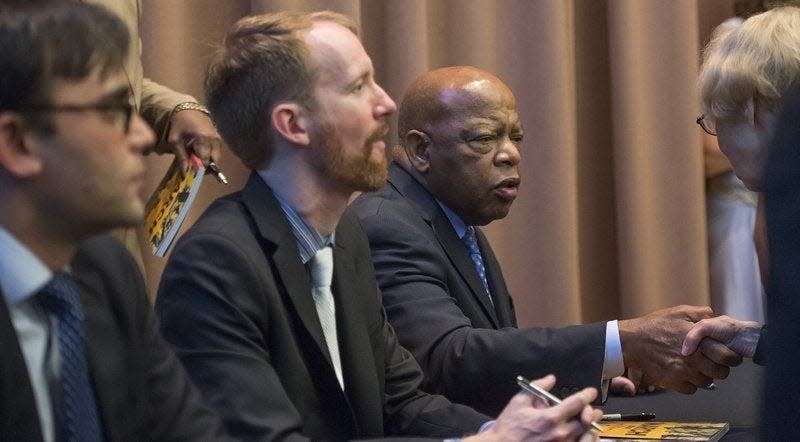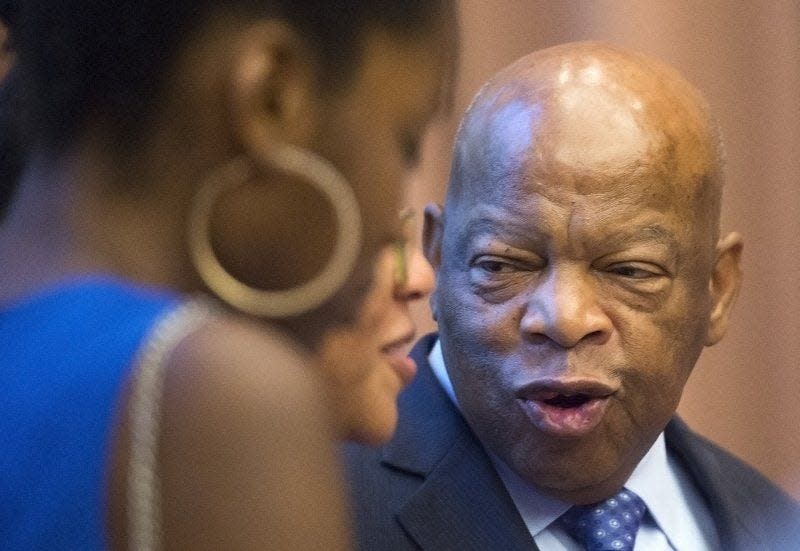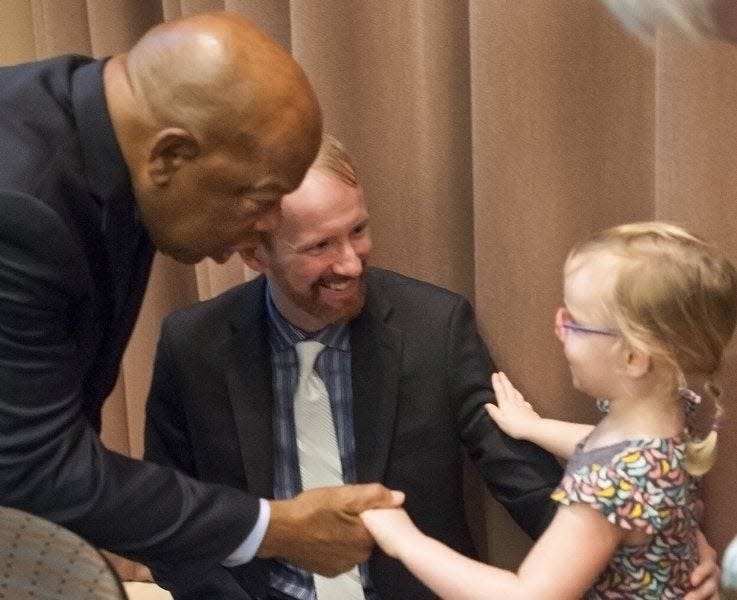Civil rights pioneer John Lewis continues to tell important stories

- Oops!Something went wrong.Please try again later.
Civil rights icon and U.S. Rep. John Lewis knows how to excite a crowd. When he walked into the reception prior to Monday’s talk in the Indiana University Auditorium, the energy in the room of IU’s Neal-Marshall Black Culture Center changed.
Lewis made his way over to the table where he, Andrew Aydin and Nate Powell would sign copies of “March: Book One” and “March: Book Two,” which are the first two books in a trilogy that tells the story of Lewis and his fight for civil rights.
Local attorney Al Manns is one of the few people at the reception who knows firsthand what Lewis was like back in his college days. Manns was a junior at Fisk University in Nashville, Tennessee, where Lewis earned his undergraduate degree. Manns stood in line to show Lewis the yearbook with pictures of both of them.
More:Graphic novelist's work evolved as he grew as a parent, artist
“That’s where I knew him,” Manns said after showing Lewis’ signature next to his senior photo.
Manns was from Ohio and knew nothing of the racial segregation problems in the South. But he was quickly schooled on the issues and took part in some of the protests.
“He came to my room and invited me to participate in a march,” Manns recalled — although he turned Lewis down because he needed to prepare for an exam.
Manns is proud to call Lewis a classmate and is also proud of the small role he played in helping promote the cause.
“I was just a soldier,” Manns said. “I was just a follower.”
Aydin, who helped author the books, has been a Lewis constituent since he was 3 years old. Aydin saw the power in telling Lewis’ story, but the Democratic Georgia congressman admitted he had to think about doing it.

“I convinced him to do it, and everybody thought I was nuts,” Aydin said.
“But I finally said yes, if you would do it with me. And I’m glad I said yes,” Lewis said before the talk.
Bloomingtonian Powell, who illustrated the book, said he knew it had the potential to reach a large audience, but preparing to speak in front of a full auditorium was more than anyone could have imagined.
“We had no idea what the potential scope or reach could be,” Powell said.
Lewis said the graphic novel format has made the book accessible for younger readers, although it has drawn older readers as well.
Justin Hunter, principal at Fairview Elementary School, attended the reception and wanted to thank Lewis for his contributions. Hunter said children read the book at the school, and were enlightened by it.
“I just wanted to thank him personally,” Hunter said.
At the reception, Kayla Frye was excited to hear Lewis again. She has heard him speak once before and was drawn to his storytelling, which brought the civil rights story to life.
“It was just the passion he had when he was speaking,” she said.
Steven Williamson was also excited. He was eager to learn more about Lewis and his advocacy as a young student. Prior to the event, Williamson brushed up on his history, too.
“I was like nerded out,” he said.

Lewis’ storytelling helps drive home a sense of the struggle that can’t often be understood. Williamson said he watched the movie “Selma,” which had a profound effect on him and his family.
“It was the first time my son saw me really cry,” Williamson said. “Think about how people were really dehumanized.”
The talk was an entertaining event, with Lewis relating stories of growing up and about how he decided to do a graphic novel. Aydin told the audience he was a comic book nerd who thought a graphic novel was a great way to reach new audiences.
As a member of Lewis’ staff, Aydin had an opportunity to tell Ethel Kennedy, a human rights campaigner who is the widow of Sen. Robert F. Kennedy, that he was working on the book and that she was in it.
“Well, that’s nice, dear,” Aydin quoted Kennedy as saying. He later received a call from Kennedy telling him the first installment of “March” was the first graphic novel to win the Robert F. Kennedy book award.
Lewis continued to inspire the crowd as he encouraged everyone to work together to continue to right the wrongs. He stressed the importance for those involved in current struggles to read the books and learn how things can be done without violence as long as people work together.
“We can change things. We can create a new America and a better America,” he said.
This article originally appeared on The Herald-Times: Civil rights pioneer John Lewis continues to tell important stories

